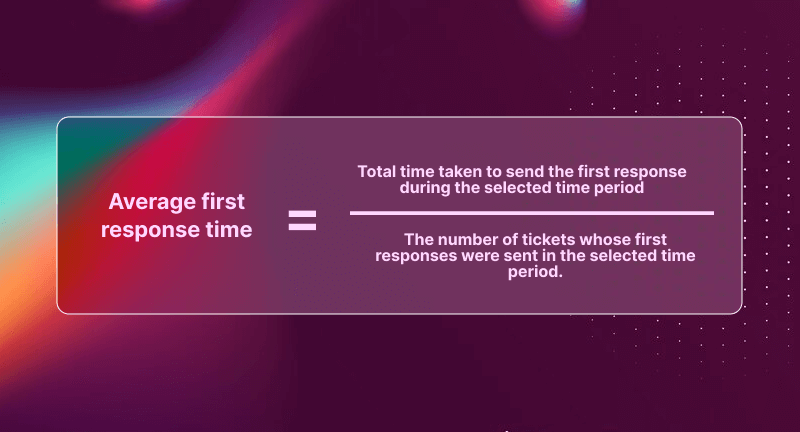
In today's fast-paced business landscape, customer service plays a pivotal role in ensuring customer satisfaction and loyalty, so how can you measure success in a call center? One of the critical metrics that call centers and customer service teams use to gauge their performance is First Response Time (FRT).
First Response Time is a standard metric for measuring the performance of your team, as it shows overall satisfaction with customer service. In this blog post, we'll delve into what First Response Time is, why it matters, and how you can measure and optimize it for improved customer service.
How can Convin help in turning your business around?
What is the First Response Time (FRT)?
First Response Time, often abbreviated as FRT, is a vital metric that measures the time it takes for a call center agent to respond to a customer's initial inquiry or request. This metric is crucial for evaluating the efficiency and effectiveness of your customer service team. FRT is typically measured in minutes or hours, and a lower FRT is generally seen as a positive indicator.
It is a crucial metric in customer support as it measures the efficiency of the team's response. However, it's not just about how quickly the support team responds; the first call resolution (FCR) or the ability to solve a customer's issue during the initial contact is equally important. Thus, businesses should maintain a balance between a short FRT and a high FCR rate to ensure optimal customer support.
Understanding the importance of FTR is essential in order to ensure the success of your organization. Certain domains are greatly affected by it.
Why Does First Response Time Matter?
For businesses, providing exceptional customer service is paramount.
One key factor in achieving this is through First Response Time (FRT) and First Call Resolution (FCR).
FRT refers to the time it takes for a customer’s inquiry to be addressed, while FCR refers to resolving their issue in a single interaction. Both are indicators of how well a business handles customer inquiries and concerns.
3 Reasons why FRT and FCR are essential for a successful business!
- Customer Satisfaction: Quick responses to customer inquiries lead to higher levels of customer satisfaction. When customers receive prompt assistance, they are more likely to feel valued and supported, which can lead to brand loyalty.

- First Call Resolution (FCR): FRT is closely related to another important metric – First Call Resolution (FCR). FCR measures the ability of a customer support team to resolve issues during the initial interaction. A low FRT contributes to a higher likelihood of achieving FCR, as quick responses can prevent problems from escalating.
- Customer Retention: Customers who receive fast responses are more likely to be retained. A slow response time can lead to frustration and even churn, as customers may seek assistance elsewhere.
Now that we've explored why First Response Time (FRT) matters in the context of customer service, let's shift our focus to the practical aspects of measuring and optimizing this critical metric. Understanding its importance is just the first step; the real value lies in effectively managing and improving FRT to enhance customer satisfaction and streamline your support operations.
Results first, payment later.
Strategies to Measure and Optimize First Response Time (FRT)
Measuring and optimizing First Response Time (FRT) is at the heart of delivering exceptional customer service. In this section, we'll embark on a two-part journey: first, we'll explore the art of measuring FRT accurately to gain valuable insights into your team's performance.
Then, we'll delve into the strategies and best practices for optimizing FRT.
So, let's begin by mastering the measurement of FRT before moving on to the essential techniques for optimization—steps to Measure First Response Time (FRT)
- Identify the Initial Contact: The first step in measuring FRT is to identify when a customer makes their initial contact. It could be when they send an email, make a phone call, or submit a query through the website.
- Log the Contact Time: Record the exact time the customer initiated contact. It becomes your starting point for measuring FRT.
- Record the Response Time: Note the exact time your team responds to the customer. It could be an automated response or a manual reply from your customer service team.

- Calculate the Duration: Subtract the initial contact time from the response time. It gives you the FRT for that particular customer query.
- Analyze and Implement Improvements: Take these individual FRT measurements and analyze them. Look for patterns, identify areas for improvement, and implement changes to decrease your overall FRT.
Remember, FRT isn't just about speed. The quality of the response is equally important. Organizations should aim for a balance between a quick response and a helpful, resolution-oriented reply. It comes by Optimizing the FRT in a way that helps the organization succeed.
Strategies to Optimize First Response Time (FRT)
- Implement Automation Tools: Employing automation tools such as chatbots can handle straightforward queries, thus decreasing the number of inquiries that need manual intervention. It allows customer service agents to focus on more complex issues, subsequently reducing FRT.
- Provide Self-Service Options: Offering self-service options like detailed FAQ pages or instructional videos can help users resolve issues on their own. It reduces the volume of inquiries, aiding in the optimization of FRT.
- Prioritize Training: Ensure that your call center agents are well-trained and capable of providing efficient and correct responses. It reduces the back-and-forth communication, thus lowering the FRT.
- Streamline Processes: Simplify and streamline customer service processes to allow faster resolution of queries. It could involve better categorization of inquiries or implementing more efficient communication channels.
- Set Clear Expectations: Communicate expected wait times to customers; explicitly stating these anticipated times can reduce frustration and improve customer satisfaction, even with longer FRT.
- Leverage Customer Feedback: Use customer feedback to identify bottlenecks and areas of improvement in your customer service process. Implementing these changes can help reduce FRT.
Now that we've covered essential strategies for optimizing First Response Time (FRT), it's crucial to understand that even with the best intentions, organizations can encounter certain pitfalls during the optimization process.
Common Pitfalls When Measuring and Optimizing FRT
Measuring and optimizing First Response Time (FRT) can be a tricky task. Some common pitfalls can impede progress and delay results.
- Neglecting Other Important Metrics: One of the major pitfalls is focusing solely on FRT, disregarding other vital metrics such as First Call Resolution (FCR).
- Overemphasis on FRT: FRT is not the sole indicator of customer satisfaction. Placing less significance on this metric can overlook other aspects like agent friendliness or helpfulness that contribute significantly to the overall customer experience.
- Lack of a Holistic Approach: Failing to take a comprehensive view when measuring and optimizing FRT can hinder improvements.
- Insufficient Training for Agents: To improve metrics such as FCR, comprehensive training for agents is essential. Neglecting this aspect can lead to inefficiencies in resolving customer queries.
- Ignoring Hold Times: Reducing hold times can play a significant role in enhancing customer satisfaction. Overlooking this aspect can impede improvements in FRT and overall customer experience.
Don’t let hold time hold your business back. Talk to the experts.
How can Convin Take Your Business to the Next Level?
Convin offers a wide range of features to improve your company's First Response Time (FRT), ultimately enhancing your business performance.
- Deep Insights: Convin provides profound insights into your customer service interactions, which can help you understand common issues and satisfaction drivers. This understanding can assist in developing effective strategies for first-call resolution, thereby improving FCR rates.
- Personalized Coaching: Convin empowers your call center agents by providing tailored coaching. It can improve their customer handling skills, leading to a higher success rate in resolving inquiries during the first interaction and reducing the overall response time.
- Monitoring and Evaluation: The platform allows you to regularly monitor and evaluate the success of your implemented strategies, ensuring consistent FTR rates and continual improvement in your service level. This proactive approach can lead to a consistent reduction in response times and a marked increase in customer satisfaction, contributing to overall business success.
- Real-Time Guidance: Real-Time Agent Assistance is a cutting-edge solution designed to empower call center agents with real-time support and guidance during customer interactions. The assistant listens to customer-agent conversations in real time, analyzing the dialogue for crucial information and customer sentiment.
Based on the analysis, the assistant provides agents with instant recommendations and suggestions to guide them in addressing customer queries and concerns effectively.

To sum it up, First Response Time is an important metric that can help businesses measure customer satisfaction and recognize opportunities for improvement in their service level. Being aware of the current standard for FRT and then measuring and tracking actual performance helps teams focus on reducing response time and increasing customer satisfaction.
Furthermore, if you're looking to implement FRT strategies in your business or wish to optimize existing time strategies – Are you curious? Get on a call with us to learn more about receiving personalized advice tailored to the needs of your professional organization.
FAQ
1. How do you measure response time?
Response time is measured by calculating the time elapsed between the moment a customer's inquiry is received and the moment a response is sent by the support team, typically in minutes or hours. This metric is crucial for assessing the efficiency of customer service operations.
2. How do I get my first response time?
To calculate your First Response Time (FRT), subtract the timestamp of when a customer's inquiry was received from the timestamp of when your support team sent the first response. It provides the time it takes to acknowledge the customer's initial request.
3. What are the tools to measure response time?
Standard tools to measure response time include customer service software with built-in reporting and analytics, which track response timestamps, and third-party monitoring services that record and report response times for websites and online services. These tools help businesses accurately assess and improve their customer service performance.
4. What is the minimum response time?
The minimum response time is the shortest amount of time it takes for a customer service agent or system to acknowledge a customer's inquiry, typically measured in minutes or seconds. It represents the quickest response achievable and is a critical component of First Response Time (FRT) metrics.































.webp)



.png)







